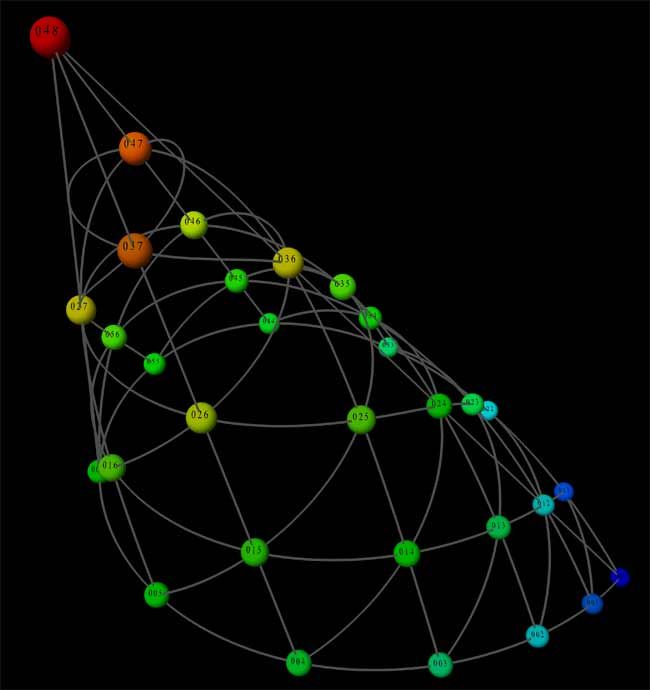Music Reduced to Beautiful Math

It’s hard for anyone to say what music looks like, but a new mathematical approach sees classical music as cone-shaped and jazz as pyramid-like.
The connections between math and music are many, from the unproven Mozart effect (the idea that playing Mozart's music to children might improve their mathematical abilities) to the music of the spheres (the ancient belief that proportions in the movements of the planets could be viewed as a form of music). Now scientists have created a mathematical system for understanding music.
Clifton Callender of Florida State University, Ian Quinn of Yale University and Dmitri Tymoczko of Princeton University outlined their "geometrical music theory" in the April 18 issue of the journal Science.
The team designed a geometrical technique for mapping out music in coordinate space. For music made of chords containing two notes, all musical possibilities take the shape of a Möbius strip, which basically looks like a twisted rubber band (this was first described by Tymoczko in a 2006 Science paper). The team found that the shape of possibilities using three-note chords is a three-dimensional ice cream cone, where types of chords, such as major chords and minor chords, are unique points on the cone. The space of four-note chords is what mathematicians would call a "cone over the real projective plane," which resembles a pyramid in our 3-D universe. Any piece of music can be mapped in these spaces.
"You can use these geometrical spaces to provide ways of visualizing musical pieces," Tymoczko told LiveScience. "These spaces give us a much better and comprehensive picture of the space of all possible chords."
When they first realized that the shape of two-note chords is a Möbius strip, a fundamental mathematical form discovered in the 19th century, the researchers were "amazed," Quinn said.
"But there was also a sense in which we weren’t surprised, because any composer who has spent any time futzing around on a piano invariably finds their fingers end up twisted in a knot," he said. "Knowing that there's a good mathematical reason for that is deeply satisfying."
Sign up for the Live Science daily newsletter now
Get the world’s most fascinating discoveries delivered straight to your inbox.
It's probably no coincidence that math and music are so deeply linked, he said.
"When music doesn't have words, it doesn't necessarily resemble anything in the real world," Quinn said. "This is a feature people have been amazed by and found remarkable and a little bit terrifying. Traditionally, paintings always looked like things, poetry and literature were talking about things. But music is coming closer to pure truth. People who talk about mathematics say the same thing — it's not necessarily about anything, it's just truth."
The new techniques reveal fascinating differences between rock and classical music, and even between Paul McCartney and John Lennon.
McCartney's pieces make use of a smaller number of motions in the geometrical spaces, corresponding to his more traditional approach to harmony, while Lennon makes use of a much wider set of options, reflecting his roots in rock, Tymoczko said.
"One of the really exciting things about this research is that it allows us to see commonalities among a much wider range of musicians," Tymoczko said. "In some sense, Bach and the Beatles are really exploiting the same geometrical features. In that sense they're not radically different."
By looking at the mathematical essence behind the work of various musicians and musical styles, the scientists can better understand how they relate to one another.
"You certainly see large trends," Tymoczko said. "Over the course of the 18th and 19th centuries people start exploring a wider variety of geometrical spaces. There's a general push toward increasing complexity and sophistication. They move from the three-dimensional cone to the four-dimensional space."
While analyzing the math behind music can provide many insights, it doesn't answer all of our questions.
"A lot of people say, 'Will this help us understand which Britney song is going to be a hit and which one isn't?'," Tymoczko said. "There's no hope of that. There is no way that geometry is going to help you become a great composer. Understanding the geometry will help you become a mediocre composer much more quickly, but composing is an artistic achievement. There's no royal road to becoming a great musician. We're not taking the mystery away from music."
- Why Music Gives Us The Chills
- Video: Play Pinch Harmonics On Guitar
- Math Idol: Voters Pick Greatest Equations












